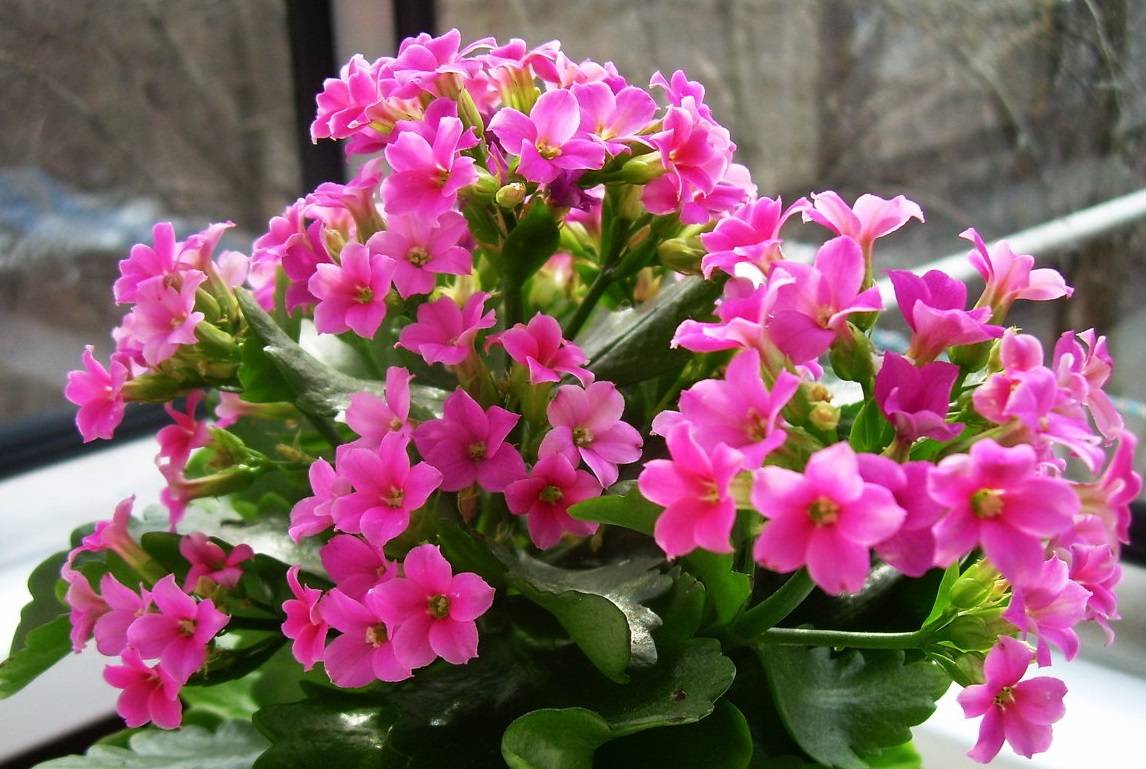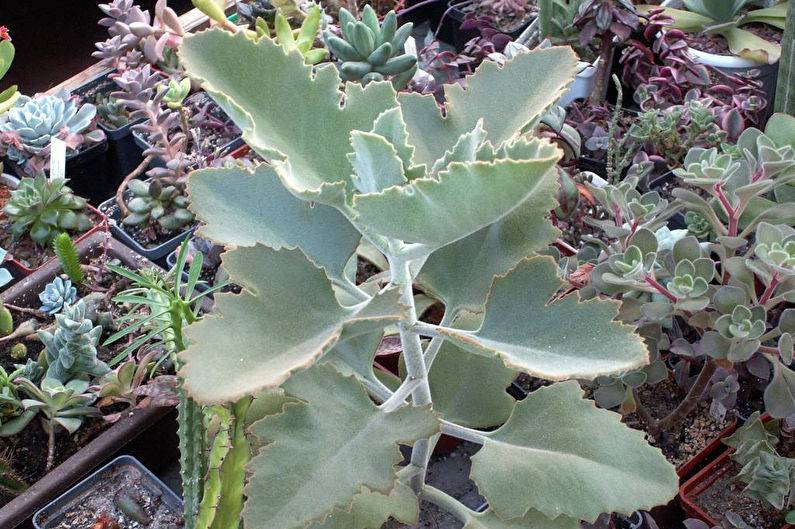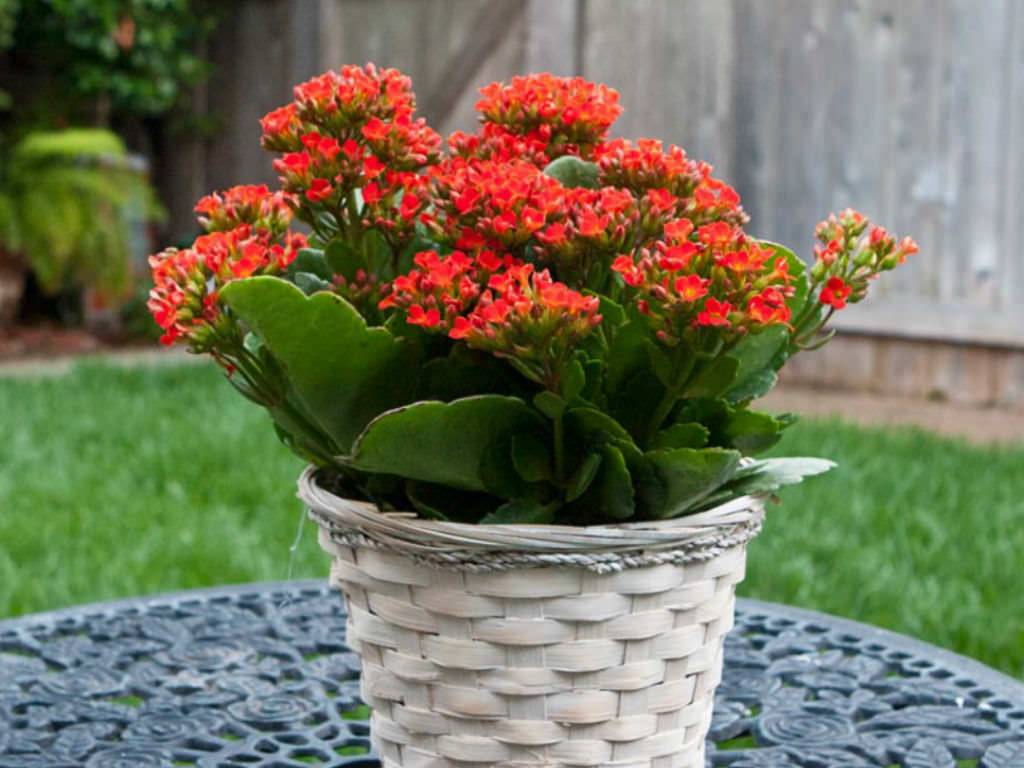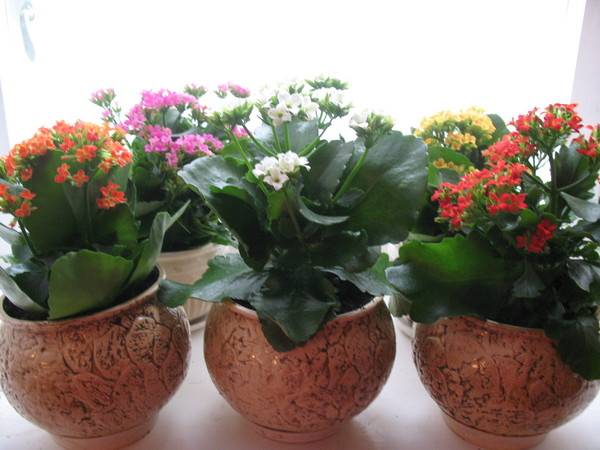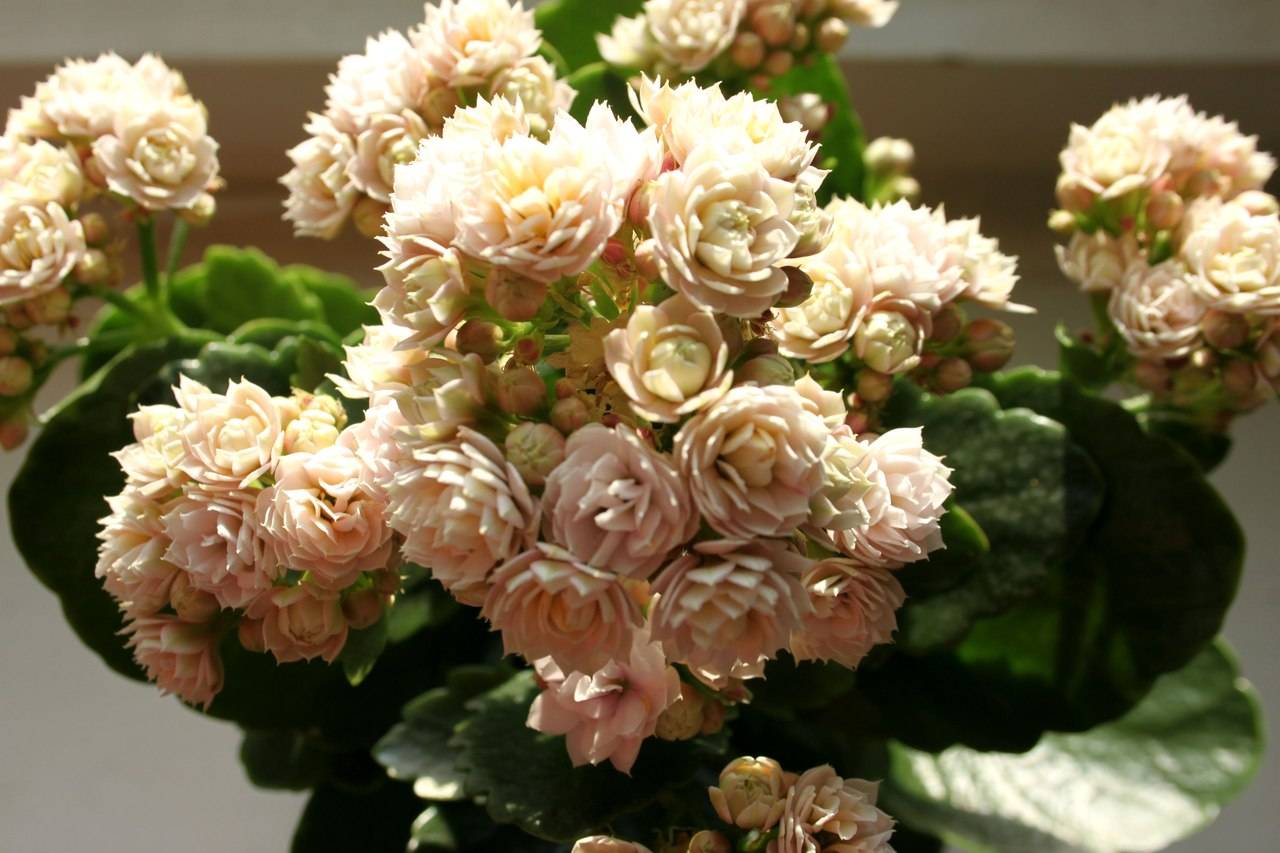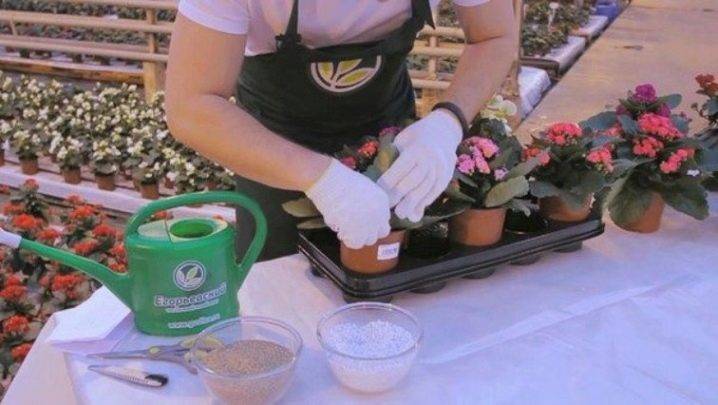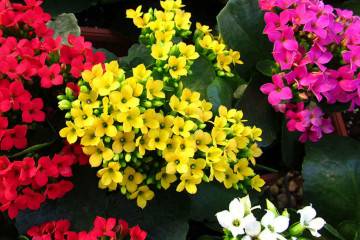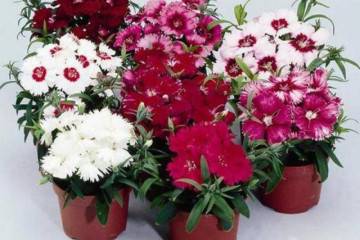Kalanchoe - home care
Content:
Kalanchoe is an ornamental plant that comes from Madagascar. The family has about 200 subspecies. Some varieties are able to quickly form daughter shoots directly on the leaves. Below is how to grow this flower at home and whether it can be planted outside.
Kalanchoe - what is this flower
Kalanchoe is a representative of the Fat family, succulent and cactus, no matter how strange it sounds. A succulent plant can grow from 3 cm to 2 m, it all depends on the species. Leaves are thick plates capable of storing moisture. Kalanchoe is used in medicine and cosmetology, the plant has healing properties.
Short description
Kalanchoe forms in nature are ampelous or woody. Succulent plants are flowering, decorative-deciduous, medicinal. Like all cactus, all types are unpretentious in care, varieties do not require frequent watering and pruning. Flowering is quite long. Indoor bushes are compact. Among flower growers, hybrid varieties are popular, which differ in a variety of colors.
Kalanchoe leaves are rather thick, they are located on short petioles. The shape of the leaves is varied, it is oblong, round, triangular. The edges of the leaves are even, wavy, finely toothed. The color of the foliage is also different: from greenish to reddish.
Flowers are usually small, up to 1 cm in diameter. In the inflorescence there are four partially accrete corollas. The result is a tube of flower petals. Flowering is umbrella-shaped, rarely paniculate.
Medicinal use
The flower has a positive effect on inflammation and purulent formations that are outside or inside the body. The plant contains:
- oxalic acid;
- Apple acid;
- vitamins A, C;
- polysaccharides;
- enzymes.
Folk recipes with Kalanchoe are indispensable for burns, wounds, abrasions. The sap of the plant successfully copes with scurvy and periodontal disease. For stomatitis, daily rinsing is recommended.
Healing qualities are possessed by an ointment from the juice or pulp of a plant. The use of the drug is possible for various skin diseases, there are practically no contraindications.
Popular Kalanchoe: species for home cultivation
Kalanchoe is quite popular among lovers of indoor flowers; it is recommended to plant the plant for novice growers.
Kalanchoe tubular (Kalanchoe tubiflora)
Tirsiflora is another name for this flower, which is quite large, up to 60 cm. A distinctive feature is the many thin and long leaves of about 10 cm. Numerous buds grow on the upper shoots. They are usually greenish, grayish or brown.
Kalanchoe paniculata (Kalanchoe thyrsiflora)
The plant is distinguished by very dense foliage, up to 60 cm high. The leaves are elongated and slightly rounded. The foliage is silvery green with red blotches along the edge. Dissolves small flowers, collected in paniculate inflorescences.
Kalanchoe felt (Kalanchoe tomentosa)
The plant is distinguished by oblong leaves, which are about 5-6 cm long. The foliage is framed along the edge with a brown stripe and edging. Kalanchoe blooms very profusely, but the flowers are small, collected in inflorescences.
Kalanchoe Blossfeld (Kalanchoe blossfeldiana)
The plant is distinguished by its small height (30-45 cm) with rounded wavy leaves and red flowers, which are collected in umbellate inflorescences. Hybrid species with white, yellow, orange and purple flowers are popular among flower growers. Mini-forms are also grown that have bright red flowers.
Kalanchoe manginii (Kalanchoe manginii)
The plant is distinguished by thin stems, which are about 30 cm long. In adult specimens, the branches sag. The succulent foliage is dark green in color. The edges of the leaves are even, oval and slightly wavy.
The flowers of the variety are red, they form brood buds. Among flower growers, hybrid varieties are popular, which have a variety of flower colors.
Kalanchoe bentii
This is the bristle-leaved Kalanchoe, which belongs to the low-branched dwarf shrubs. The flower is powerful, reaches a height of 1 m. It has 6 pairs of rounded leaves up to 40 cm in length. The flowers are collected from umbellate inflorescences and are usually white. The flowers have a tube at the corolla, swollen at the base, 2.5 cm long.
Abundant flowering is observed in April-May. During this period, the plant is especially effective, regardless of location. Kalanchoe blooms even in cool rooms.
How to care for a Kalanchoe flower at home
Almost all Kalanchoe do not require special care at home. Plants are responsive to fertilizing with mineral fertilizers, they can bloom several times a year. Organic substances can be added less often, there will be no harm from them.
Illumination and temperature conditions
Kalanchoe is photophilous, with a lack of lighting they stretch out. Bright light affects full development, so the flower pot can be placed in direct sunlight. Succulents thrive in outdoor temperatures. In summer, it is kept up to 30 ° C.
Watering rules and humidity
This factor does not really matter for the plant. In the summer, in extreme heat, spraying will not harm. Species with velvety leaves should not be subjected to this procedure.
Top dressing and soil quality
For succulents, soil with the addition of sand is acceptable. If the soil is prepared at home, you can mix leafy, turfy soil, peat, sand in equal amounts. For drainage, add brick chips or charcoal.
Over time, the quality of the soil deteriorates, so top dressing is necessary. You can take special fertilizers for cacti.If the species is flowering, add fertilizer for the flowering species.
Flower container size
The Kalanchoe pot can be plastic or ceramic with holes at the bottom. The plant does not tolerate stagnant moisture. An ordinary clay pot will be the best option for this succulent plant. It is important to consider the minimum amount of free space.
A container for a small succulent should have a diameter of 12-17 cm, the choice depends on the type and variety.
Pruning and replanting
Kalanchoe can be replanted annually after flowering. A larger container size must be selected each time.
Pruning involves removing excess leaves and flowers. The procedure contributes to the correct formation of the crown. After pruning, a small bush will look original.
Can the Kalanchoe be planted outside
In the summer, the Kalanchoe will feel good outdoors in the open field. Also, a flower in a pot can be taken out to a balcony or terrace.
At what time of the year is it done
The plant can be transplanted into open ground in the summer, like any other indoor flowers, the succulent will respond positively to a change of scenery. For a flower, you can choose a dry place where direct sunlight rarely looks. If the Kalanchoe is blooming, the plant will perfectly decorate the flowerbed.
Features of Kalanchoe care in the open field
It is recommended to gradually accustom succulents to the sun and fresh air. For example, on the first day, a flower with a pot can be taken out for an hour, then the time can be increased by two hours. It is important to repeat the procedures daily with a gradual increase in the time of exposure to the sun.
Nuances of flowering plants
The Kalanchoe bloom is repeated annually. A scattering of inflorescences appears from mid-January to March. With proper care, flowering is extended throughout the summer.
A period of activity and rest
The first wave of budding occurs in March. New flower buds are laid after the timely removal of dried flowers. Also Kalanchoe must be provided with feeding.
With good agricultural technology and optimal keeping conditions, the flower is replete with flowers for a very long time. If the bush does not lay buds, the reason lies in improper care, and infection with diseases is also possible.
Types and shape of flowers
Kalanchoe is a flower that differs in shape and color, it is white, yellow, pink or red. The flowering varieties are quite interesting and unusual. The shape of the buds is also different. For example, in some varieties, flowers are bells, which are collected in panicles. Peduncles are long.
Other species are distinguished by the presence of long arrows with bunches of small flowers. There are species with bunches of inflorescences that stay on the plant for a very long time, up to 3 months. Terry Kalanchoe is very beautiful, the flowers of which look like small roses in a bouquet. Terry species are distinguished by larger and more varied flowers.
Flower reproduction methods
The most popular reproduction of Kalanchoe species buds. However, for some reason, daughter plants do not grow on all varieties, so other methods are chosen.
Reproduction of Kalanchoe by cuttings
This method is applicable at any time of the year. For the cutting, an adult leaf is cut from the mother plant. This part is planted in a pot of fertile soil, covered with a glass or jar. A rooted leaf forms into a full-fledged Kalanchoe in just a few weeks.
Growing from seeds
The seeds of flowering Kalanchoe, which are easy and simple to care for at home, can be planted in early spring. They have good germination, but only in well-drained and fertile soil. The seed must be scattered on the surface and then covered with glass or foil. With the emergence of seedlings, the shelter should be removed. Young plants later need to be transplanted into separate containers.
Growing problems, diseases and pests
The main diseases of the succulent:
- late blight;
- powdery mildew;
- stem rot;
- ring spot.
Kalanchoe pests:
- mealybug;
- shield;
- aphid;
- ticks.
To restore a diseased plant, drafts, temperature changes, excessive aridity or waterlogging of the soil should be excluded.
Kalanchoe, home care for which consists of watering every three days, will surely respond with lush flowering. It is important to provide him with regular transplanting and pruning, as well as regular feeding with formulations for cacti. Moreover, the rules of care must be adhered to constantly.
